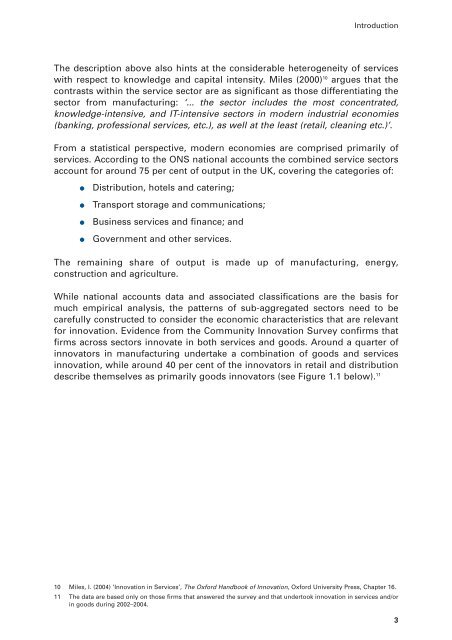Innovation in Services - Department for Business, Innovation and Skills
Innovation in Services - Department for Business, Innovation and Skills
Innovation in Services - Department for Business, Innovation and Skills
You also want an ePaper? Increase the reach of your titles
YUMPU automatically turns print PDFs into web optimized ePapers that Google loves.
The description above also h<strong>in</strong>ts at the considerable heterogeneity of services<br />
with respect to knowledge <strong>and</strong> capital <strong>in</strong>tensity. Miles (2000) 10 argues that the<br />
contrasts with<strong>in</strong> the service sector are as significant as those differentiat<strong>in</strong>g the<br />
sector from manufactur<strong>in</strong>g: ‘... the sector <strong>in</strong>cludes the most concentrated,<br />
knowledge-<strong>in</strong>tensive, <strong>and</strong> IT-<strong>in</strong>tensive sectors <strong>in</strong> modern <strong>in</strong>dustrial economies<br />
(bank<strong>in</strong>g, professional services, etc.), as well at the least (retail, clean<strong>in</strong>g etc.)’.<br />
From a statistical perspective, modern economies are comprised primarily of<br />
services. Accord<strong>in</strong>g to the ONS national accounts the comb<strong>in</strong>ed service sectors<br />
account <strong>for</strong> around 75 per cent of output <strong>in</strong> the UK, cover<strong>in</strong>g the categories of:<br />
● Distribution, hotels <strong>and</strong> cater<strong>in</strong>g;<br />
● Transport storage <strong>and</strong> communications;<br />
● Bus<strong>in</strong>ess services <strong>and</strong> f<strong>in</strong>ance; <strong>and</strong><br />
● Government <strong>and</strong> other services.<br />
Introduction<br />
The rema<strong>in</strong><strong>in</strong>g share of output is made up of manufactur<strong>in</strong>g, energy,<br />
construction <strong>and</strong> agriculture.<br />
While national accounts data <strong>and</strong> associated classifications are the basis <strong>for</strong><br />
much empirical analysis, the patterns of sub-aggregated sectors need to be<br />
carefully constructed to consider the economic characteristics that are relevant<br />
<strong>for</strong> <strong>in</strong>novation. Evidence from the Community <strong>Innovation</strong> Survey confirms that<br />
firms across sectors <strong>in</strong>novate <strong>in</strong> both services <strong>and</strong> goods. Around a quarter of<br />
<strong>in</strong>novators <strong>in</strong> manufactur<strong>in</strong>g undertake a comb<strong>in</strong>ation of goods <strong>and</strong> services<br />
<strong>in</strong>novation, while around 40 per cent of the <strong>in</strong>novators <strong>in</strong> retail <strong>and</strong> distribution<br />
describe themselves as primarily goods <strong>in</strong>novators (see Figure 1.1 below). 11<br />
10 Miles, I. (2004) ‘<strong>Innovation</strong> <strong>in</strong> <strong>Services</strong>’, The Ox<strong>for</strong>d H<strong>and</strong>book of <strong>Innovation</strong>, Ox<strong>for</strong>d University Press, Chapter 16.<br />
11 The data are based only on those firms that answered the survey <strong>and</strong> that undertook <strong>in</strong>novation <strong>in</strong> services <strong>and</strong>/or<br />
<strong>in</strong> goods dur<strong>in</strong>g 2002–2004.<br />
3
















